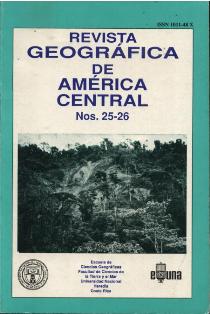DESLIZAMIENTOS EN LA CUENCA MEDIA Y SUPERIOR DEL RIO REVENTADO, CARTAGO, COSTA RICA
Keywords:
río Reventado, deslizamientos, Cartago.Abstract
La cuenca del río Reventado, situada en la vertiente sur del Volcán Irazú, Costa Rica, presenta actualmente un riesgo para la ciudad de Cartago (aproximadamente 30.000 habitantes), especialmente para algunos asentamientos cercanos al río mismo. Este riesgo consiste, en primer lugar, en un deslizamiento con grandes extensiones en la parte inferior de la cuenca media, el deslizamiento llamado San Blas. Este deslizamiento está formado por la antigua terraza de Banderilla de material de avalanchas holocenas y que fue activado en el comienzo de la década de los setenta por la destrucción de su sostén por la explotación de materiales en tajos. Anteriormente, la última vez en los años 63-65, el riesgo era diferente:
Erupciones del Irazú con grandes cantidades de cenizas originaron un cambio violento del régimen hidrológico, intensas lluvias causaron crecidas y avalanchas, profundizando en la cuenca superior los cauces y provocando así deslizamientos. En la cuenca baja estas avalanchas provocan inundaciones y acumulaciones de los abanicos diferentes. Los deslizamientos activados por estos eventos actualmente muestran poca o ninguna actividad, pero el riesgo de repeticiones de estos eventos persiste.
SUMMARY
The Rio Reventado watershed, situated in the southern slope of the Irazú volcano, Costa Rica, presents a risk for the town of Cartago (30.000 inhabitants) and specially for some settlements near the river. In first place, this risk consists of a huge landslide in the lower part of the watershed, the<<San Blas- landslide, which is formed by the labaric material of a Holocene terrace of the Reventado, called <<Banderilla- terrace>>. At the beginning of the seventies this terrace was activated due the explotation of its materials in two quarries. The risks existing before in this watershed were of an other nature, an example give the events of years 1963-65:
A violent hydrologic change in the upper part of the Reventado watershed due to the ashfall of an eruption of the Irazú caused big mudflows whish depend the river beds and thus provoked landslides. These mud flows caused inundations and accumulations in the lower watershed. Today, the land slides activated in the sixties are stable or semistable, but the risk of repetitions still persists.
Downloads
How to Cite
Issue
Section
License
Proposed policy for journals offering Open Access
Authors publishing their works in the Journal acknowledge and agree to the following terms:
a) Authors retain the copyrights to their works and guarantee the Journal the right to be the first to publish their works, under the Creative Commons License Attribution-NonCommercial-ShareAlike 4.0 International, CC BY-NC-SA 4.0 International (https://creativecommons.org/licenses/by-nc-sa/4.0/deed.es), which allows others to share works upon complying with the acknowledgment of authorship and mention of the Journal as the original publisher of the work.
b) Authors are permitted to separately establish additional agreements for the non-exclusive distribution of the official edition of the work published in the Journal (for example, authors may desire to place the work in an institutional repository or incorporate it into a book that is to published elsewhere) so long they acknowledgment to recognize the Journal as the original publisher. The aforementioned additional agreements must respect the terms of the non-profit character and sharing philosophy of the original license (CC BY-NC-SA 4.0 International, https://creativecommons.org/licenses/by-nc-sa/4.0/deed.es).
c) Authors are encouraged to archive the post-print or editor/PDF version in Open Access repositories.






 REVGEO is licensed under https://creativecommons.org/licenses/by-nc-sa/4.0/deed.es
REVGEO is licensed under https://creativecommons.org/licenses/by-nc-sa/4.0/deed.es
.svg_4.png)

_(1).png)
_(1)_(1)_(1)_1.png)
(2)(1)(1)(1).png)
